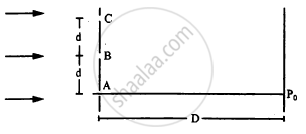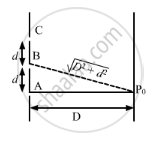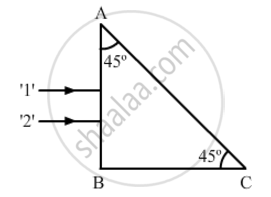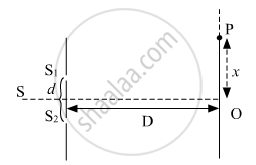Advertisements
Advertisements
प्रश्न
The following figure shows three equidistant slits being illuminated by a monochromatic parallel beam of light. Let \[B P_0 - A P_0 = \lambda/3\text{ and }D > > \lambda.\] (a) Show that in this case \[d = \sqrt{2\lambda D/3}.\] (b) Show that the intensity at P0 is three times the intensity due to any of the three slits individually.

उत्तर
(a) Given:-
Wavelength of light = \[\lambda\]
Path difference of wave fronts reaching from A and B is given by
\[∆ x_B = {BP}_0 - {AP}_0 = \frac{\lambda}{3}\]
\[ \Rightarrow \sqrt{D^2 + d^2} - D = \frac{\lambda}{3}\]
\[ \Rightarrow D^2 + d^2 = D^2 + \frac{\lambda^2}{9} + \frac{2\lambda D}{3}\]
We will neglect the term \[\frac{\lambda^2}{9},\] as it has a very small value.
\[\therefore d = \sqrt{\frac{\left( 2\lambda D \right)}{3}}\]
(b) To calculating the intensity at P0, consider the interference of light waves coming from all the three slits.
Path difference of the wave fronts reaching from A and C is given by
\[{CP}_0 - {AP}_0 = \sqrt{D^2 + \left( 2d \right)^2} - D\]
\[ = \sqrt{D^2 + \frac{8\lambda D}{3}} - D ........\left(\text{Using the value of d from part a} \right)\]
\[ = D \left\{ 1 + \frac{8\lambda}{3D} \right\}^\frac{1}{2} - D\]
Expanding the value using binomial theorem and neglectingthe higher order terms, we get
\[ D\left\{ 1 + \frac{1}{2} \times \frac{8\lambda}{3D} + . . . \right\} - D\]
\[{CP}_0 - {AP}_0 = \frac{4\lambda}{3}\]
So, the corresponding phase difference between the wave fronts from A and C is given by
\[\phi_c = \frac{2\pi ∆ x_C}{\lambda} = \frac{2\pi \times 4\lambda}{3\lambda}\]
\[ \Rightarrow \phi_c = \frac{8\pi}{3}\text{ or }\left( 2\pi + \frac{2\pi}{3} \right)\]
\[ \Rightarrow \phi_c = \frac{2\pi}{3}...........(1)\]
Again, \[\phi_B = \frac{2\pi ∆ x_B}{\lambda}\]
\[ \Rightarrow \phi_B = \frac{2\pi\lambda}{3\lambda} = \frac{2\pi}{3}..........(2)\]
So, it can be said that light from B and C are in the same phase, as they have the same phase difference with respect to A.
Amplitude of wave reaching P0 is given by
\[A = \sqrt{\left( 2a \right)^2 + a^2 + 2a \times a\cos\left( \frac{2\pi}{3} \right)}\]
\[ = \sqrt{4 a^2 + a^2 + 2 a^2 \sqrt{3}}\]
\[ \therefore l_{po} = K \left( \sqrt{3} r \right)^2 = 3 K r^2 = 3l\]
Here, I is the intensity due to the individual slits and Ipo is the total intensity at P0.
Thus, the resulting amplitude is three times the intensity due to the individual slits.

APPEARS IN
संबंधित प्रश्न
'Two independent monochromatic sources of light cannot produce a sustained interference pattern'. Give reason.
Two monochromatic rays of light are incident normally on the face AB of an isosceles right-angled prism ABC. The refractive indices of the glass prism for the two rays '1' and '2' are respectively 1.35 and 1.45. Trace the path of these rays after entering the prism.

When light travels from a rarer to a denser medium, the speed decreases. Does this decrease in speed imply a reduction in the energy carried by the wave?
What kind of fringes do you expect to observe if white light is used instead of monochromatic light?
A monochromatic ray of light falls on a regular prism. What is the relation between the angle of incidence and angle of emergence in the case of minimum deviation?
State the essential conditions for diffraction of light ?
When monochromatic light travels from a rarer to a denser medium, explain the following, giving reasons:
(i) Is the frequency of reflected and refracted light same as the frequency of incident light?
(ii) Does the decrease in speed imply a reduction in the energy carried by light wave?
State Huygen’s principle. Using this principle explain how a diffraction pattern is obtained on a screen due to a narrow slit on which a narrow beam coming from a `=> n = (vlamda)/(vlamda_omega)`monochromatic source of light is incident normally.
"Monochromatic light should be used to produce pure spectrum". Comment on this statement.
State with reason, how the linear width of the central maximum will be affected if
(i) monochromatic yellow light is replaced with red light, and
(ii) distance between the slit and the screen is increased.
Monochromatic fight of wavelength 198 nm is incident on the surface of a metallic cathode whose work function is 2.5 eV How much potential difference must be applied between the cathode and the anode of a photocell to just stop the photocurrent from flowing?
Answer the following question.
In the diffraction due to a single slit experiment, the aperture of the slit is 3 mm. If monochromatic light of wavelength 620 nm is incident normally on the slit, calculate the separation between the first order minima and the 3rd order maxima on one side of the screen. The distance between the slit and the screen is 1.5 m.
(a) Can the interference pattern be produced by two independent monochromatic sources of light? Explain.
(b) The intensity at the central maximum (O) in Young's double-slit experimental set-up shown in the figure is IO. If the distance OP equals one-third of the fringe width of the pattern, show that the intensity at point P, would `"I"_°/4`

(c) In Young's double-slit experiment, the slits are separated by 0⋅5 mm and the screen is placed 1⋅0 m away from the slit. It is found that the 5th bright fringe is at a distance of 4⋅13 mm from the 2nd dark fringe. Find the wavelength of light used.
Using the monochromatic light of the wavelength in the experimental set-up of the diffraction pattern as well as in the interference pattern where the slit separation is 1 mm, 10 interference fringes are found to be within the central maximum of the diffraction pattern. Determine the width of the single slit, if the screen is kept at the same distance from the slit in the two cases.
Assertion(A): The photoelectrons produced by a monochromatic light beam incident on a metal surface have a spread in their kinetic energies.
Reason(R): The energy of electrons emitted from inside the metal surface, is lost in collision with the other atoms in the metal.
Monochromatic light of wavelength 600 nm is incident from the air on a water surface. The refractive index of water is 1.33. Find the
- wavelength,
- frequency and
- speed, of reflected and refracted light.
Monochromatic light of wavelength 396 nm is incident on the surface of a metal whose work function is 1.125 eV. Calculate:
- the energy of an incident photon in eV.
- the maximum kinetic energy of photoelectrons in eV.
The Figure below shows a ray of monochromatic light LM incident on the first surface AB of a regular (equilateral) glass prism ABC. The emergent ray grazes the adjacent surface AC. Calculate the angle of incidence. (Refractive Index of glass = 1.5)

